These areas are to remain untouched. If possible, no exotic planting is to take place in and around open
wetland. These areas are dominated by Juncus elfuses and are to be protected at all costs.
Plant List
(Rooi grass areas and virgin veld)
These areas are as important as the wetlands, as they are the dominant plant group, or the “should be”
dominant plant group of the area. It would be foolish to over-plant these areas to exotic trees, as the veld
requires full sun, and would alter the scenic beauty of the grassland negatively.
Plant List
Where pristine should be left untouched, only application would be controlled burning.
To be planted in dominant stands in moist stream gullies, not in the wetlands. They form colonies and
create interest, game corridors and act as effective evergreen screening between houses. Plant to create
character and increase bird life.
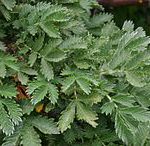
This is a small tree of great character which grows in the eastern parts of South Africa. It is a very versatile addition to the indigenous garden. The ouhout is often a straggly shrub or a dense, small, evergreen tree, which grows up to 7m tall to 5m wide. It is single or multi-stemmed and branches low down. The bark is rough, reddish brown in colour and flakes off to reveal a smooth light brown under-bark. The leaves are alternately arranged, compound and covered with silky, silver hairs.
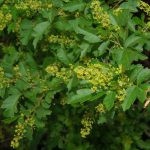
A medium sized, deciduous tree, reaching a height of about 5 metres and a spread of 4 metres. It occurs naturally in almost the whole of South Africa. t is frost-hardy and should be planted in full sun. The tree produces small, creamywhite flowers in masses, which turn into small, flattened drupes (5-6mm) which turn red, orange or brown when ripe. The drupes attract birds which feed on them.
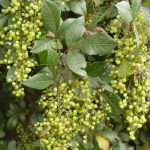
A variable shrub or small tree up to 7m tall, usually with leafy branches from the ground level and a rounded crown. The Common wild currant is ecologically important in South Africa. The bark is rough and grey or dark brown in colour. Young stems are green, often with velvety hairs, and often bearing stout thorns.
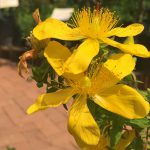
A shrub, occasionally a small tree. Leaves opposite, closely spaced and crowded at the ends of branches, c. 20 × 5 mm, green to slightly glaucous, sessile, clasping at the base. Flowers terminal solitary, showy, bright yellow, up to 5 cm in diameter. Fruit a reddishbrown capsule, up to 13 × 10 mm.
(Bush clumps, dominated by Budleja salvifolia)
Planted to create thick, dense bush clumps which could ultimately become little forests, i.e. protection
for other tree species to self seed. These enjoy the south-facing slopes of dam walls and moist,
protected gullies and streams / water courses. They create effective screening where no exotics should
be planted – i.e. natural veld areas.
Note: All indigenous planting should be encouraged and planted in areas where it would normally be
found, so as not to create a contrived or forced style of planting, but rather to create a feel that is real
and true to the landscape. They will develop over seasons to create diverse pockets and habitats for
animals and humans alike to appreciate and use.
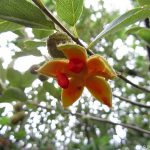
The seed pods of the Wild Peach Kiggelaria africana are hard round knobbly greenishyellow capsules that split open to expose shiny black seeds, enclosed in an oily, sticky, bright orangered coat. Crowned Hornbill, Olive Woodpecker, Cape Thrush, Cape Robin and mousebirds among other birds enjoy these fruits.
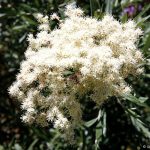
Fragrant & profusely borne clusters of creamy white, honey scented flowers practically cover this rare, South African Buddleja from Spring to mid-Summer. It’s easy, fast growing & evergreen. Also frost hardy, drought tolerant & does not have an aggressive root system. Usually growing 12’ tall & wide
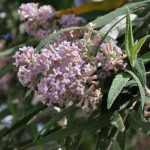
Ever- green Shrub Flower
Colour : White to cream or lilac to purple
Foliage Colour : Silver grey
Best Season : Winter to Spring
Light : Sun Hardy & fragrant.
Attracts butterflies & birds
Height: 5m
Spread: 4m
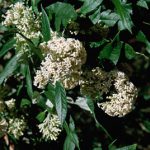
Unusual evergreen Buddleja that has its very fragrant white flowers in the autumn and winter. A useful plant for the late or is it early bumblebees that we now see all year round. Seems to be quite hardy but makes a good wall shrub in cold areas.
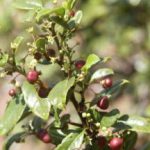
A very attractive dense shrub or a small tree that grows up to 4,5 m high. The leaves are light green when young and very dark and shiny when mature. The leaves are dark shiny above and paler below. The veins, sunken above and below, are conspicuous and covered with hairs. The fruit is favoured by many bird species. The wood is white to yellow, often streaked with brown, pink, red or green and is hard and heavy.

A medium sized, deciduous tree, reaching a height of about 5 metres and a spread of 4 metres. It occurs naturally in almost the whole of South Africa. t is frost-hardy and should be planted in full sun. The tree produces small, creamywhite flowers in masses, which turn into small, flattened drupes (5-6mm) which turn red, orange or brown when ripe. The drupes attract birds which feed on them.

A variable shrub or small tree up to 7m tall, usually with leafy branches from the ground level and a rounded crown. The Common wild currant is ecologically important in South Africa. The bark is rough and grey or dark brown in colour. Young stems are green, often with velvety hairs, and often bearing stout thorns.
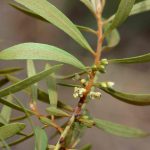
Mostly a shrub but sometimes a small tree. It may form dense stands in suitable areas. he young branches and leaves are covered in rust coloured scales. Flowers in axillary sprays, small, greenish to creamy yellow. Fruit a small reddish brown berry, becoming black when ripe.

Evergreen shrub, to 6-10 feet tall (1.8 to 3 m), 10 feet spread (3 m). can be used for espaliers or hedg- es, but will need regular trimming not to become a flat mound. I can be cut back hard if it becomes too large. Full sun.

This is a small tree of great character which grows in the eastern parts of South Africa. It is a very versatile addition to the indigenous garden. The ouhout is often a straggly shrub or a dense, small, evergreen tree, which grows up to 7m tall to 5m wide. It is single or multi-stemmed and branches low down. The bark is rough, reddish brown in colour and flakes off to reveal a smooth light brown under-bark. The leaves are alternately arranged, compound and covered with silky, silver hairs.
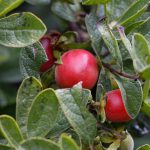
This exciting shrub or small tree is a very tough plant which grows well country-wide. Its most attractive features are its smooth bark, blue-green leaves, fragrant flowers and colourful fruits that attract many birds and insects. It flowers from September to December and fruits from January to May.
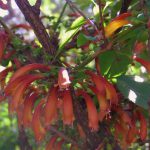
Tough, easy, fast growing & an asset to any garden, this small, evergreen tree or large shrub from South Africa is actually a member of the Foxglove family. The foliage is an attractive, glossy bright green & held on arching branches. The showy flowers are tubular, orange, red or yellow & appear in clusters in the leaf axils or on short shoots on old wood. Growing both in sun or bright shade, it likes water but does tolerate drought.
These trees (mixed evergreen and deciduous) could be planted in and around homes, as per the plan,
i.e. in densely populated clustered areas, formally planted to exotic grasses, i.e. kikuyu areas. The trees
could be grouped to screen, wind break and soften homes in the landscape.
(See the layout plan for planting zones)
GFHOA © 2023 – Privacy Notice